2010
July 2010, Galápagos taken off the red list of threatened sites
Activities during the last two years for capacity building programs to improve sustainable conservation and an for the implementation of immigration laws have led the UNESCO to take the Galápagos off the red list of world heritage sites in danger. Eviction orders against people without legal residence status have been issued for the first time in a larger scale and different initiatives have been started (see below) in response to the 2007 decision to put the Galápagos on the red list.
The UNESCO decision is a sign for very positive developments. Some organisations, however, are warning to overinterpret the decision as an indication of a lower threat level for the archipelago. In an article on 7 Aug. 2010 in the online Telegraph, Toni Darton, chief executive of the organisation Galápagos Conservation Trust is warning especially about the underestimation of spiralling numbers of tourists coming to the islands, which had been identified as the driving force of many of the conservation problems in the wake of increasing immigration to the Galápagos1. In his conclusion Toni Darton wrote: „Unmanaged tourism could destroy the Galapagos; planned tourism could save them. This is why we feel Unesco's decision is premature.“
March/April 2010, another visit by UNESCO delegation
Edouard Matoko led a team of Ecuadorian UNESCO representatives who met with the executive director and staff of the Charles Darwin Foundation during a visit of the islands. The visit aimed to build inter-institutional aggreements for collaboration in science, education, information, and culture.
2009
This was a year full of celebrations.2009 marks the 200th anniversary of Charles Darwin’s birth
and the 150th anniversary of the publication of his groundbreaking book “The origin of species”.
2009 was also the 50th anniversary for the inauguration of the Charles Darwin Foundation and for the foundation of the Galápagos National Park.
For
more details around the celebrations read here
September 2009, Initiative to support conservation and sustainable development
The UNESCOs Ecuadorian representatives and the Charles Darwin Foundations director Dr. J. Gabriel Lopez, signed an aggreement this month to coordinate Galápagos projects for sustainability with Ecuador’s National Development Plans, specifically to develop social capabilities for environmental preservation. This aggreement aims to:
- promote research to support Galápagos conservation
- support local education in favor for a sustainable develepment
- support dialogue with educative authorities in the Galápagos
- support informative actions to increase the understanding of the core issues for a sustainable conservation in Galapagos.
February 2009, satellite monitoring of vessels cruising in the marine reserve
The Galápagos National Park Service gets full direct access to the National database of registered National vessels cruising within or transiting the marine reserve.
The system will also enable to analyze current use of the sites and improve on the zoning system or to evaluate the impact of ships within protected zones and transit areas.
Furthermore it will also be easier to single out illegal ingressions of foreign fishing vessels, which have come from as far as Central America.
With the extra capacity gained through the satellite system, inspection forrays at sea will become more efficient, too. Thus, improvements in the control of prohibited fishing equipment, extraction of species that that are closed, or the fishing of specimen that do not meet minimum standards for marketing can be expected.
Read more ...
2008
December 2008, Further efforts to breed the Pinta Tortoises
In 1972 80 years-old “Lonesome George”, the last living
tortoise from the subspecies of Pinta Island, has been found and
brought to its
corral in Puerto Ayora in 1972. Since then, hopes had been high that he
would
find interest in two females of the Espaniola race, which were sharing
his
enclosure to eventually repatriate Pinta Island with their
offspring. In summer 2008, finally after many years of intense efforts
to allow
for reproduction, 14 intact eggs had been found and transferred to an
incubator. Despite high hopes and first signs of success, the eggs
eventually
turned out to be unfertilized or not viable. In spite of the
possibility that
George may be sterile, there is still hope that this year may have
marked the
start of his interest in reproduction and the years coming up might
turn out
more fertile.
October 2008, Ecuador
gives Nature fundamental legal rights
Following a referendum about its
novel constitution, Ecuador’s
legislation acknowledges a fundamental right to Pachamama, or the
Mother Earth.
It’s unprecedented to give nature such an “unalienable right to exist,
flourish
and evolve within Ecuador”
within a state’s institution. Five articles define the unalienable
right for
nature within Ecuador
to exist, flourish and evolve. Therefore, many people around the world
will be
watching with interest, how this translates into practice. Legally, the
new
laws would grant citizens the right to sue on behalf of an ecosystem,
even if
not actually injured themselves. The Charles Darwin Foundation is
working with
the Government and partners in Galapagos to establish what these
changes might
mean for Galapagos.
September 2008, Ecuador
begins transfer of illegal residents
April 2008, Wind turbines on Galápagos Islands
Read more
March 2008, Galápagos Invasive Species Fund
and an earlier CEDENMA report on the issue
2007
December,read more at the Galápagos conservation trust site
August - A good choice for the Galápagos
26 June 2007
more at the sites of UNESCO
and the Charles Darwin Foundation
Key points as outlined in the report by the authors Graham Watkins and Felipe Cruz are (among others):
- the driving force for drastic changes on the Galápagos during the last 15 years is tourism with a 14% average annual growth.
- main cause for this increase is a weakened governmental leadership in Galápagos without a long-term strategy on development
- Increase in tourism pushes the demands for public services and jobs, which are part of a vicious cycle of growth
A more complete outline can be found here
March/April 2007 - Military violence sparks new conservation plans for the Galápagos
more at http://www.reevolucion.org/portal/ [Spanish]
2006
November 2006 - Ever increasing number of people arriving in the Galápagos pose a new threat: the West-Nile Virus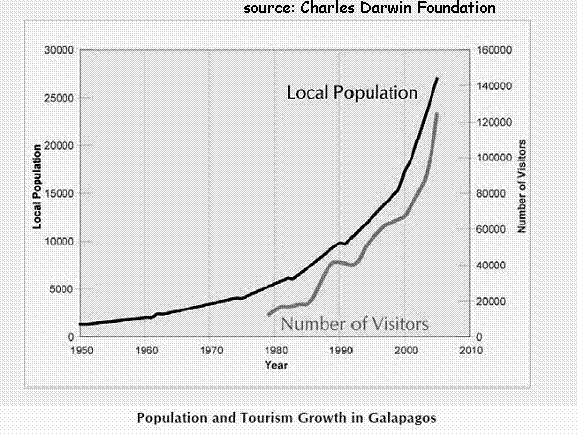 Its introduction to
Galápagos can only be prevented with a stringent implimentation
and improvement of the current inspection and quarantine system. This
system,
however, suffers
from the lack of personnel and the situation
is amplified by ever increasing
numbers of human arrivals (see
figure
courtesy Charles Darwin Foundation). By the end of this year a third
airport is scheduled to start receiving incoming international flights
on Isabela island. Last spring has also set a mark with the arrival of
the first cruise liner bringing in 500 passengers
at once, which had been traveling
tropical waters only days and weeks before. It is nearly impossible to
sufficiently control such
large liners to prevent transport of invasive species. This is an
increasing
threat to that main asset that made the islands special in the first
place: isolation from the continent and from among each other.
Isolation was the driving force for radiation of species so unique to
the Galápagos, which are the main cause for tourist and
scientists alike to come to islands. Millions of years of isolation,
however, make these species very vulnerable to invasive species from
the outside. More cruise liners and aircrafts coming in will further
advance immigration of people working in tourism, which in turn will
spur new transports of goods and the construction of new
infrastructure... a vicious circle.
Its introduction to
Galápagos can only be prevented with a stringent implimentation
and improvement of the current inspection and quarantine system. This
system,
however, suffers
from the lack of personnel and the situation
is amplified by ever increasing
numbers of human arrivals (see
figure
courtesy Charles Darwin Foundation). By the end of this year a third
airport is scheduled to start receiving incoming international flights
on Isabela island. Last spring has also set a mark with the arrival of
the first cruise liner bringing in 500 passengers
at once, which had been traveling
tropical waters only days and weeks before. It is nearly impossible to
sufficiently control such
large liners to prevent transport of invasive species. This is an
increasing
threat to that main asset that made the islands special in the first
place: isolation from the continent and from among each other.
Isolation was the driving force for radiation of species so unique to
the Galápagos, which are the main cause for tourist and
scientists alike to come to islands. Millions of years of isolation,
however, make these species very vulnerable to invasive species from
the outside. More cruise liners and aircrafts coming in will further
advance immigration of people working in tourism, which in turn will
spur new transports of goods and the construction of new
infrastructure... a vicious circle.August 2006 - Galápagos remains on UNESCO's World Heritage List
July 2006 - Isabela Eradication project successfully completed
See report at the Galápagos Conservation Trust.
May 2006 - New 10-years strategic plan
The Charles Darwin Foundation launched a new strategic plan to face the challenges ahead for the next ten years.
This plan can be downloaded online.
May 2006 - Galápagos National Park's new head: a woman director
more details (so far only in Spanish)
Interview with Sra. Raquel Molina
2005
Nov 2005 - UNESCO World Heritage Committee's first analysis on the state of the National Park- credibility and authority of the National Park Service should be restored
- the special law for Galápagos, which sets
the legal framework for all activities, must be fully implemented by
Feb. 2007, a report should be sent one year ahead with special emphasis
on the control of migration and illegal fishing
- a joint initiative with the UNESCO, Ecuador, and other UN bodies should be set up to develop a long-term vision for sustainable development of the Galápagos.
October 2005 - Mass tourism on Galápagos?
more details
July 2005 - more news on longlining
During a meeting held on 29 and 30 June, the probibition of the use of longlines for fishing in the Galápagos marine reserve (GMR) has been confirmed by the Inter-institutional Management Authority. This is an important decision for conservation (see earlier contribution), however, the ruling refers to a layer of water from the sea surface to a depth of 60 meters, which is the layer that is most critical for catching large numbers of unwanted species, the so-called by-catch, as has been shown by results of investigations on the impact of longlining carried out between 1994 and 2003. The Galápagos Conservation Trust writes in its breefing, that "last week's decision means that any future proposal to evaluate the possible use of long lines within the GMR must consider setting long lines with the hooks deeper than 60 meters. As Graham Watkins, executive director of the Charles Darwin Foundation is being quoted: "Studies in other parts of the world show that the risk of being caught on hooks is reduced if hooks are deployed at greater depths."
Discussions on this issue will continue inspite of the recent ruling. A proposal of local stakeholders has already been started to analyse the feasibility and commercial viability of fishing for large pelagic fish. Concern for future proposals for longlining in depths greater than 60 meters could be the inability to control adherence to the depths restrictions.
The local newspaper El Mercurio wrote on July 4th, that the decision has already been rejected by the fishery stakeholders and the president of the Unión de Cooperativas de Galápagos, Rogelio Guaicha, who's statements, that his group is sick of more and more studies, has been interpreted as an open threat for the resumption of protests and strikes in the Galápagos.
Meanwhile, there are efforts to allocate funds to support local Galapageńos to give up their occupations in the fishing sector in order to change into jobs in the tourism sector. The minister for the environment, Ana Albán, anounced the opening of a fund for which her government will allocate 1.5 million US $, and an Italian syndicate and the Banca Popolare Etica declared financial support for the new efforts.
further details: http://www.gct.org/jul05_2.html
The Municipality of Puerto Ayora rectifies obstacles on the main jetty for marine iguanas
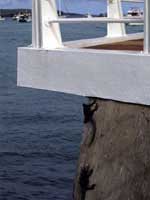
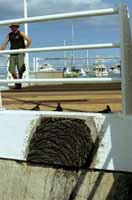 The municipality of Puerto Ayora, main town in
Galápagos, had built a new promenade about about two years ago.
During its inauguration
the new promenade had
been praised as an important
step toward the modernization of the town and increase of the quality
of life. And ever since it is attracting new forms of nightlife, with
more and more inhabitants gathering for a night walk, open air
concerts, auto scooters or to catch the weekend amusement train in
Disney fashion. The quality of
life, however, had decreased for the few local marine iguanas, which
still live in the area of the port. Once they used
to climb up the rough jetty walls and bask on top of it. The concrete
top of the new promenade,
however, made this impossible for any but a few of the
smallest and lightest iguanas. On the advice of nature conservation
groups in Puerto Ayora, the municipality modified the
side walls and added new structures
marine iguanas can now use to climb up the jetty.
The municipality of Puerto Ayora, main town in
Galápagos, had built a new promenade about about two years ago.
During its inauguration
the new promenade had
been praised as an important
step toward the modernization of the town and increase of the quality
of life. And ever since it is attracting new forms of nightlife, with
more and more inhabitants gathering for a night walk, open air
concerts, auto scooters or to catch the weekend amusement train in
Disney fashion. The quality of
life, however, had decreased for the few local marine iguanas, which
still live in the area of the port. Once they used
to climb up the rough jetty walls and bask on top of it. The concrete
top of the new promenade,
however, made this impossible for any but a few of the
smallest and lightest iguanas. On the advice of nature conservation
groups in Puerto Ayora, the municipality modified the
side walls and added new structures
marine iguanas can now use to climb up the jetty.June 2005 - World summit on evolution successfully concluded on San Cristobal
210 people attended from June 8-12, graduate students and senior scientists alike in a conference on the history of evolutionary thoughts, on theoretical as well as empirical models and recent developments of evolutionary research. The meeting was hosted by the Universidad San Francisco in Quito at the location, where Darwin's ship the Beagle, first arrived in the Galápagos archipelago nearly 170 years ago.
read more detail written by one of the participants: http://www.sciam.com/article.cfm?chanID=sa004&articleID=00020722-64FD-12BC-A0E483414B7FFE87
June 2005 - update on fishing issues in the marine reserve
Sea cucumbers fulfill an ecological function which can be compared to the earthworms of grasslands. A study by the Charles Darwin Foundation demonstrated that overfishing of cucumbers caused a decline in the density of these animals from 34 per square meter sea surface in 2001 to 0-4 per square meters in 2004. Therefore, a two year moratorium on sea cucumber fishing had been established in 2004. This is obsolete with the most recent consession that allows the harvest of 3 million animals during a open window of three months, starting June 2005. The new minister of environment, Ana Albán has been quoted to explain this decision by the Institutional Management Authority (AIM) with the words "We decided to open fishing of sea cucumbers, mainly due to social and economic considerations."
for more information on both developments see: http://www.igtoa.org/newsletter/2005/may-june/
April 2005 - The UNESCO World Heritage Site under scrutiny
April 2005 - Fishing with longlines to be allowed in the marine reserve of the Galápagos Islands?
see also:
http://www.igtoa.org/newsletter/february05/
http://www.naturalworldtours.co.uk/articles2005/march/march1205d.htm
http://www.birdlife.net/print.html?url=%2Fnews%2Fpr%2F2005%2F04%2Fecaudor_ibas.html
http://www.ecoworld.com/Home/articles2.cfm?TID=246
The Isabela Project started in 1998, financed by the UN with the mission to restore the environments on the islands Santiago, Pinta, and Northern Isabela. So far, Santiago is believed to be freed of feral pigs and donkeys. Feral goats are still being eradicated on the islands Isabela and Santiago. Already they became so sparse on Isabela, that the natural vegetation is visibly recovering on the slopes of the volcano Alcedo, which hosts a big population of giant tortoises, which were previously suffering from lack of food and shelter within the degraded vegetation. Felipe Cruz, the coordinator of the project, reports that "during 2004, more than 7,450 ground hunting and 975 helicopter hours have been invested on Santiago and northern Isabela and the results are impressive."
see also:
http://www.gct.org/project1.html
http://www.gct.org/isabela1.html
April 2005 - Transgressions by private sport fishing yachts illustrate loss of power on the side of the National park authorities
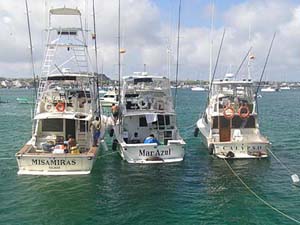 In February 2005 several private yachts
entered the marine
reserve of the Galápagos islands for a planned sport fishing
tournament, which was organized by the Salinas Yacht Club, the
International Game Fishing Association and the Billfish Foundation.
Their legal basis was a transit license issued by the marine
authorities. However, soon after their
arrival the minister of environment Juan Carlos Camacho responded
to National Park activities and adopted a resolution (Acuerdo
Ministerial número 014)
which would prohibit the issuing of licenses for every kind of
sport fishing in the marine reserve until a pending legislation on
sport fishing activities in the Galápagos would be in place. Everybody
then expected the boats to leave San Cristobal, where the yachts were
based. But nothing happened. What happened was that the yachts were
regularly pursuing illicit fishing activities on a commercial basis
while inviting foreign clients, stayed in National Park area without
permission, and violated basic existing National Park ruling, embarking
on National Park visitor sites without appropriate permits and without
any guide attendance. Any landing of tourist vessels on National Park
visitor sites is highly regulated and not possible without the
attendance of trained Park guides. In general, no private boat is allow
on land anywhere in the protected National Park zones of the
archipelago.
In February 2005 several private yachts
entered the marine
reserve of the Galápagos islands for a planned sport fishing
tournament, which was organized by the Salinas Yacht Club, the
International Game Fishing Association and the Billfish Foundation.
Their legal basis was a transit license issued by the marine
authorities. However, soon after their
arrival the minister of environment Juan Carlos Camacho responded
to National Park activities and adopted a resolution (Acuerdo
Ministerial número 014)
which would prohibit the issuing of licenses for every kind of
sport fishing in the marine reserve until a pending legislation on
sport fishing activities in the Galápagos would be in place. Everybody
then expected the boats to leave San Cristobal, where the yachts were
based. But nothing happened. What happened was that the yachts were
regularly pursuing illicit fishing activities on a commercial basis
while inviting foreign clients, stayed in National Park area without
permission, and violated basic existing National Park ruling, embarking
on National Park visitor sites without appropriate permits and without
any guide attendance. Any landing of tourist vessels on National Park
visitor sites is highly regulated and not possible without the
attendance of trained Park guides. In general, no private boat is allow
on land anywhere in the protected National Park zones of the
archipelago.The National Park authorities had tried to intervene and implement sanctions, but the only executive authority that could force the boats to leave were the marine forces. But nothing happened. Even worse, when a Park-owned plane took pictures of those yachts while fishing on sea, their owners complained on the basis of regulations on private air traffic and the plane was called back by the authorities. Eight yachts were still in place when we took this picture in March 28 and were going out for regular illegal fishing activities. When anchored at Puerto Baquerizo Moreno, owners, personnel and their well-paying guests can move in and out of town freely, no police, no marine executives hampering their activities. The arrogance of the power of money is becoming obvious. Illustrative of their influence is the fact that the Salinas Yacht Club is even displayed on a Ecuadorian stamp. People in town call good connections and payoffs to local politicians responsible for this erosion of the National Park authority. Meanwhile Artmarina, Red Mangrove, Blue Marlin Lodge, and "Galapagos sport fishing co." still run their advertisements on respective internet pages, promoting exclusive fishing experiences on board of luxurious yachts, still continuing to pursue illegal activities unhampered in the waters of the Galápagos marine reserve, while lying to their prospective customers that "Recently, after extreme consideration by the Galapagos authorities, this activity will be permitted under world-class environmental controls"*.
The Galápagos Conservation Trust writes in his news release: "What is happening now is setting a negative precedent for the management of the Marine Reserve and erodes the authority of the Galapagos National Park Service. Moreover, it opens the door to other activities inappropriate to the Marine Reserve and indeed to the sustainable development of the community. The Galapagos Alliance views sport fishing as a tourist activity that might be valid for the Marine Reserve and which might, under adequate controls, make a positive contribution to reducing the impact of fishing. It would also respond to the demands of artisanal fishermen for alternative sources of income. The vital regulations should be produced more speedily and there should be sanctions on the afore-mentioned activities."
More information can be found at:
http://www.gct.org/mar05_2.html
http://www.igtoa.org/newsletter/january/sportfishing.php
* comment: The grammatical mistake made in this quote seems to imply that fishing had "recently" been approved [which is wrong], but the choice of further wording "will be permitted" is more closely to the truth that a final decision is still pending, as of the beginning of April.
April 2005 - Recent large scale deaths of marine iguanas on the island of San Cristobal
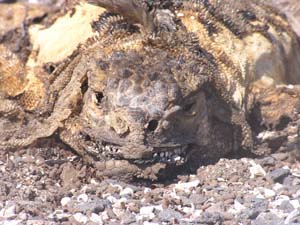 In
February 2005 the local office of the National Park Service in San
Cristobal had been notified about several dead corpses of marine
iguanas which were found along the coast of the naval base right at the
edge of the main town Puerto Baquerizo Moreno. At least two of the
corpses had black, necrotic heads, what led to the fear of a possible
outbreak of a new infectious disease. A possible connection with
the wrecked oil- tanker Jessica was also invoked, a wreckage from
2001, still aground the bay only a few hundred meters away from the
points where the cadavers were found. A group of scientists from the
Laboratorio of the National Park, visiting scientists from Italian
Universities, members of the Charles Darwin Research Station, and we
were
heading for San Cristobal to investigate the case.
In
February 2005 the local office of the National Park Service in San
Cristobal had been notified about several dead corpses of marine
iguanas which were found along the coast of the naval base right at the
edge of the main town Puerto Baquerizo Moreno. At least two of the
corpses had black, necrotic heads, what led to the fear of a possible
outbreak of a new infectious disease. A possible connection with
the wrecked oil- tanker Jessica was also invoked, a wreckage from
2001, still aground the bay only a few hundred meters away from the
points where the cadavers were found. A group of scientists from the
Laboratorio of the National Park, visiting scientists from Italian
Universities, members of the Charles Darwin Research Station, and we
were
heading for San Cristobal to investigate the case.During this first survey along about 1.5km of coast, Park wardens found about 70 carcasses of marine iguanas, some old, some recent. At most of the recent corpses, signs of bites could still be recognized, marks of teeth of a size that could be attributed only to an animal of the size of a dog. Some living animals had mortal infections from wounds, like pulmonia, or necroptic tails. Infections, which also seemed to have spread out from wounds almost certainly caused by dog bites. There was a relief that no infectious disease was causing the deaths, and that there was no imminent threat of an epidemic. However, this relief was derogated by the sheer number and ghastly appearances of the many deaths we were recording.
Again, most of the cadavers, which were fresh enough to be investigated, and many of the living animals showed bite marks from a jaw of the size a dog would have. Rats and cats have been discussed as culprits, too. However, our data suggest that rats and cats only come into the play once marine iguanas are either seriously wounded, or dead. Several times we found fresh dog prints on smoothed sand, which had been left by dogs roaming the coast during the night. Almost all of these tracks were of similar size, left by a middle-sized dog. Therefore, at least for the first section of coast close to town, it could be that we are dealing with only one dog, which may be responsible for most of the casualties. It is very unlikely that he killed the iguanas. Most of the wounds and signs of bites were found on the tails of iguanas. During the night, they sleep on top of rocks or in between the rocks. But even in the latter case their tails are usually hanging outside, unprotected. During sleep, marine iguanas are quite sluggish and responsive very late, making it easy to grab them. Very likely, we are not dealing with a wild beast raving mad, out to kill iguanas, but rather with a stray domestic dog, which found out it's fun to pull and shove iguanas at night and chew on their tails, when they are stuck between the rocks. Usually this does not kill the iguanas, but causes only minor wounds. Wounds, however, which are regularly followed by infections causing the tissue to rot and ultimately the death of the iguana. While marine iguanas are very capable to heal wounds from blows and tears, which they suffer frequently in the rough surf of the sea between sharp-edged lava rocks, we could see how vulnerable they are to the bacterial load in wounds caused by even minor dog bites. Something they had no chance to adjust to during their isolated evolution on an island without native ground predators.
What can be done about it? The National Park Service is currently trying to find the dog or dogs responsible for the fatalities close to town in order to catch or kill them. Simultaneously, the Park is using poisoned meat baits, which is an easier solution, but more troublesome in our view. We will follow up here with updates as soon as any news become available.
On the long run, any events like the current deaths must be prevented preemptively. In May 2005, Animal Balance [see article below] will be starting a campaign on San Cristobal, which is all about dog neutering and education for responsible pet ownership. This is hopefully a further strong contribution to stem the tide of stray and feral dogs, which can cause havoc among the native fauna. As such, the program is invaluable. However, as has been shown from the recent deaths in San Cristobal, one single dog may be enough to extinguish part of a population, solely through uncontrolled, playful behavior. Therefore, all efforts possible have to be made to reduce the number of dogs, and to prevent any new dogs to be brought into a place, where they should not be. Even something as simple as this, preventing new imports of dogs from the mainland, however, has its loopholes. There are rumors about corruption among the INGALA, the "National Galapagos Institute", a governmental organization; corruption that may be responsible that pure breeds such as a bulldog and a dalmatian recently showed up in the main town in the archipelago, Puerto Ayora, although legislation prohibits any transports. As anywhere else, environmental issues on Galápagos are foremost political issues, and the inability to change the political climate makes cases, like the recent deaths of marine iguanas, appear so frustrating. Because the real problem can not be fixed merely with the removal of a dog...
January 2005 - Neutering and spaying of domestic dogs and cats in the townships of Galapagos
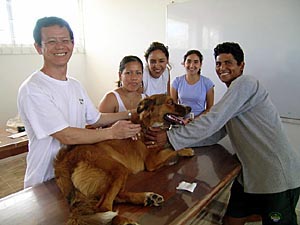 Shelley Thomas has good news when looking back upon Year
2004. She is co-ordinator of the spay and neuter project "Conservation without Cruelty" run
by WildAid,
recently partnering with US-based animal welfare group Animal Balance.
This project, which kicked off in January 2004 offering free
sterilization clinics backed up by education campaigns pushing
responsible pet ownership, is turning the tide on an over-population of
dogs and cats in the townships of Galapagos.
Shelley Thomas has good news when looking back upon Year
2004. She is co-ordinator of the spay and neuter project "Conservation without Cruelty" run
by WildAid,
recently partnering with US-based animal welfare group Animal Balance.
This project, which kicked off in January 2004 offering free
sterilization clinics backed up by education campaigns pushing
responsible pet ownership, is turning the tide on an over-population of
dogs and cats in the townships of Galapagos. It’s thought domestic animals were first introduced into Galapagos by English privateers. Numbers of dogs and cats have since sky-rocketed, evident in a recent census placing the population at 2,500 in Puerto Ayora alone, where, with other “introduced species” such as rats, goats, donkeys, pigeons and pigs (and humans), they threaten future sustainability of unique ecosystems.
Dogs have been dumped on the street, allowed to breed out of control, caught in a vicious cycle of uncontrolled breeding and neglect. They run in packs, scavenge from garbage, prey on endemic creatures, and create a potential risk to the public.
In only one year the the project has managed to spay and neuter 864 dogs and cats in the townships of Puerto Ayora and Puerto Villamil. It started the process or registering pets, inserting identification micro-chips, and giving owners collars and leads. Obviously, the key benefit can be seen in a reduction in the population of strays. But, Shelley Thomas is also convinced that compassion for one animal, leads to greater compassion for all creatures.
The biggest problem, aside from differing cultural attitudes towards pets, is the lack of finances available to most Galapagueńa families without outside help to participate in the program.
<Find out more> or contact Shelley Thomas from WildAid Galapagos, or Animal Balance founders Emma Clifford and Allice Ng.
2004
overview
In 2004 several dramatic struggles were fought over the natural resources within the Galápagos National Park.
While conflicts over the presidential decree still continued, the fishing cooperative tried to push through changes on the quota for the harvest of sea cucumbers in their own favor. These animals yield large profit margins on Asian markets. Once very common all over the archipelago, the population drastically declined due to overexploitation. They are similarly important for the marine environment as are earthworms for the enrichment of soil. As part of the protests the area of the National Park Administration and the Charles Darwin research station was occupied by armed fishermen and access for employees was blocked, sometimes by violent means. Only protracted negotiations and a ruling by the Ecuadorian court could stop the strike of fishermen, giving in to some of the demands of the fishing lobby.
The last view years have seen many cases of illegal fishing activities by local fishermen but also by big companies based in the mainland of Ecuador, in other South-American countries and as far as Costa Rica and Asia. The intrusions of big fishing boats from the waters outside the reserve are difficult to monitor let alone to convict, due to the large size of the marine reserve. With marine resources diminishing in other areas, the Galápagos marine reserve attracts more and more poachers. A method of particularly high profit and cruelty is the hunt for shark fins. Again, this peculiarity serves Asian markets, where fins yield large profits as aphrodisiac and delicacy. Usually, fins are cut off and the live animals thrown back into the sea facing a slow death. After all, there are some positive news on the shark line. In 2004 a Year of the Shark campaign was launched to raise awareness for the increasing problem of illegal shark finning. The export of shark fins from Ecuador was finally banned. This also complicates the smuggling of fins from the Galápagos Islands onto the mainland of Ecuador and into foreign countries.
In mid-September of 2004, a new National Park director was appointed by the president of Ecuador, unilaterally ending the short term in office for the existing director Edwin Naula. Thus, eight different people directed the National Park within the last two years, all appointed by the president. This sparked the protest of Park wardens who wanted more continuity and their outstanding salaries to be paid. The newly appointed director was joined by some 100 fishermen on his first day to work, forcing his way into his office, what resulted in a violent confrontation, using clubs and throwing rocks, calmed down only by tear gas from the police. International protest rose quickly and a delegation of Park wardens was sent to the minister of environment in Quito. Finally, the new appointment was retracted end of September and wages were payed. A new interim director Victor Carrion was agreed upon and a new commission founded, which now will establish ways how to elect a new Park director. This should avoid one-sided political influences during the process of nomination of future directors and also grant more continuity through a term of office for four years.
Events of the last year indicate that the delicate balance between the exploitation and conservation of natural resources in the Galápagos marine reserve is under heavy strain. Currently, changes in the use of natural resources take place, which will essentially determine their sustainability and future availability for tourism, local communities and fishermen. The reasons for these changes are the rapidly growing local population, the decrease in the populations of native marine animals, and the corresponding urge of many fishermen to increase their catch and switch to more profitable illegal fishing methods. Alternatively, first fishermen start to abandon fishery in order to gain income in tourism.
Many if not most tourists traveling the Galápagos are not aware of these developments. Important decisions about the future of the Galápagos are being made these days. As far as tourism is concerned, every visitor to this paradise on earth should be aware that he or she can profoundly influence the fate of the islands with his choice over which trips to book. We recommend to take sustainability and quality of the guides, allocated to a boat, into account. This not only helps nature, it also guarantees a richer experience. You can inquire beforehand about the efforts an agency makes to avoid transport of invasive plants and animals between the islands, to minimize pollution of the waters and keep up with security and conservation standards set forth by the National Park. Be responsible and enjoy the wonders of a world that in many areas still are the same that Darwin admired on his tour in 1838 on board of the ship Beagle.
--------------------------------------------------------------------------------------------------------------------------------------------------------------------------
You can find more details as well as current news from the Galápagos on the following pages:
- News from the
Galápagos Conservation Trust
- BBC news - photo gallery
- Biodiversity conservation and human population impact
- Sea Shepherd
- BirdLife International
- Shark
project
- Reglamento Especial de Turismo [Spanisch]
- Guardaparques del Parque Nacional Galápagos (Spanish news release)
- El Cedenma (Spanish)
- http://www.igtoa.org/
- http://www.reevolucion.org/index.html
(Spanish)
- http://www.igtoa.org/newsletter/january/